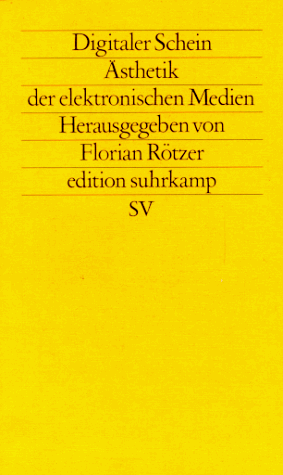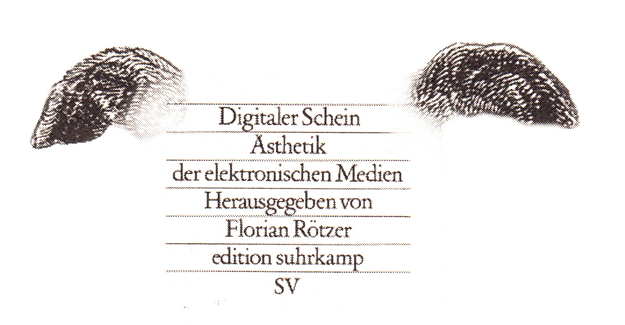He was the compiler of the two special Kunstforum issues, 'Ästhetik des Immateriellen' (no.97/98) and no.100 on art and philosophy. He also reports on conventions and festivals and is the editor of Tumult, the journal for communication science. His many interviews are collected in Französische Philosophen im Gespräch, Denken, das an der Zeit ist and Kunst machen (with Sara Rogenhofer). In light of his service record, the publishing giant Suhrkamp asked Rötzer to compile an anthology on the consequences of electronic media for the practice of artists. As part of the Suhrkamp foundation, which ranks as a paragon of the critical establishment, Digitaler Scheinwill certainly cause psychic shock among adherents of house philosopher Habermas. The postmodern tone did not need to be airbrushed away and Rötzer was evidently able to do things his own way.
Whether Rötzer himself chose for the critical approach or whether it came about on request of the Suhrkamp editor responsible is of little importance. Worthy of note is that there are certain differences between this book and the Kunstforums by Rötzer's hand. The anthology opens with a 70-page introduction by Rötzer in which, first off, he cautions against the misuse of techno-art by commerce and politics. This is fostered by the fact that many a 'media work's' content is subject to its form. In order to escape the clutches of high-tech promotion, according to Rötzer, art, philosophy and technology should strive for unity.
This unity is personified in the figure of Leonardo da Vinci, which is a reason for Rötzer to insert a separate section entitled Mirror of the Renaissance. Academies for media art should facilitate this unity - he warns these new institutes lest they degenerate into electronic technical schools.
The introduction, which looks more like an essay, gives a comprehensive survey of the philosophical concepts which are at present circulating around the theme of the 'machine aesthetic'. Rötzer is especially interested in the 'derealization' which synthetic worlds bring about. He is curious as to the effects of simulations, fragmentations and acceleration on the 'artist-philosopher' (Nietzsche). The search for new forms of expression can, however, be overrun by the impulse for synthesis and connectivity, which Rötzer classifies as ideology of the information society. This art no longer thrives in the closed sphere of the studio or the museum, but is connected from the beginning to a network, called the Gesamtdatenwerk by Roy Ascott. Art and technology get connected to each other in order to prod the requisite creativity out of the programmers and designers. Rötzer never takes up the eternally recurring question of whether this can be called real art. He points, rather, to media art in its practice, where it is the least autonomous of all. The fusion of disciplines and interests has made the question superfluous.
Rötzer professes to be irritated, but does not distinctly express his discomfort about the 'Medial and the Digital' in words, nor can it be traced in his choice of authors and subjects. The 30 contributions in Digitaler Schein give the impression that he plumped for an encyclopedic approach. But what is a reader to look up here? Only an occasional article really deeply penetrates the material, such as Edmont Couchot's, which explains the difference between optical,
synthetic and numerical images. Bernhard Vief's contribution on digital money is also worth reading. He compares McLuhan and Marx and sees money as a new medium which is brought like data to the databank. On the other hand, Digitaler Schein cannot be called an introduction for the lay reader. The art-historical discourse, supplemented with some philosophy, has displaced the Marxist jargon of the social sciences and can keep writing this way endlessly.
In his compilation Rötzer chose a mix of, on the one hand, prominent authors who embroider on their own stories, and on the other, media artists who have been at it for a while and can thus give an overview of developments since the 1960s. Baudrillard discusses the virulence of the virus and the fractal poetry which the text must possess if it is to take up the challenge of the media. Dietmar Kamper sees media as a second nature whose consequence is a disarming of the senses. Vilém Flusser proposes that we have become not subjects, but projects. And of course there is Virilio, who reports on the transition from reality via topicality to virtuality.
On the artists' side we find Gene Youngblood, who sees metamedia as a tool for renaissance amateurs who no longer work in the avant garde but radiate a positive attitude as part of the electronic community. Their social meta-design is a reconstruction which seeks the realization of the Self. Frank Popper gives a historical overview of High Tech Art in which the first computer artists, videomakers and tele-artists pass in review. The old timer in the field, Otto Piene (of the Center for Advanced Visual Studies at mit) continues with the historical approach and sums up the numerous art forms under the term 'light art'. Those who want to know what cavs/mit does and who has done what can find out in this piece, but it is no more than a plug for Piene's own work.
Cover of "Digitaler Schein, Ästhetik der Elektronischen Medien" - 
Then there is a survey of holography and an interview with Heinrich Klotz, the director of the Center for Art and Media Technology in Karlsruhe. Klotz reveals himself as a realist who is manoeuvring carefully now that the euphoria over media art in politics and the public has died down. In this conservative era techno-art is allowed to act humble and seek alliance with the classic arts (and not vice versa). According to Klotz's liberal interpretation, we have now entered a pluralistic era in which old and new media are equal and need each other. He does not wish to treat painting, ballet or opera badly (Media technology for me is not the successor to what was previously art). Klotz wishes to avert the danger that the new art will go in its own direction, will not be understood by subsidizers and critics, for instance by employing simulation technology in didactic education. The computer is no more than an instrument in the service of a higher Gesamtkunstwerk, in which all disciplines must converge. Klotz dismisses the individual paths being sought by media artists in the virtual worlds, which are presenting themselves as experts' culture, and thus bars them. An enlightening discussion that indicates how little daring there is to let media art and theory go their own way.
I have yet to discuss Peter Weibel's contribution, which gives clear definitions, slaughters sacred cows and defends media art against the integrative tendency.
After handling the aesthetic systems of Kant, Hegel and Heidegger, he shows that the classic trinity work-being-truthhas gone bankrupt in the technological revolution and been replaced by the simulation-sign-power triangle. Weibel gives a lot more variants of these three linked terms, something which can come across as just a bit of word-juggling. The decided way in which Weibel founds his arguments seems to inspire aversion. The cocktails from his discourse blender do not taste good. Weibel's forays through the classic library do indeed take on McLuhanian forms (McLuhan is also poorly read). Because of this, Weibel's important contribution to the term 'techno-art' threatens to get overlooked.
Weibel's proposition is that art which uses technological media differs radically from the art that came before. Media art is a transformation, maybe a transgression; it rewrites and surpasses the classic arts. It is thus for Weibel part of the tradition of 20th century anti-art. Media art distorts, fragments, deconstructs and fights the urge for a discourse of unity. It makes the machine explicit, which otherwise remains cryptic and thus disrupts the symbolic order.
Making the technology in media art visible is not a temporary experiment, but its essence. The question of power is posed: namely, that of the currency of classical aesthetics. Its terms are mere stagings of power and have never been more than an aesthetic of the static, which is no match for dynamic art.
Techno-art is against appearance as being, against power as truth, against nature as necessity. It is for fiction as a significant of change, for the sign as a variable of freedom, for the media as the guest accommodations of nature.
These are programmatical statements which Kant, Hegel and especially Heidegger leave in the dust (Anti-art is against Heidegger). Alluding to Foucault, Weibel would like to see the birth of the gallery written. He takes art in one breath with the clinic and the prison. The old ontologists kept silent about the existence of these inevitabilities of power so as not to endanger their dominion as an 'implicit system'. Media art too has fallen prey to this, and also Digitaler Schein in a certain sense. That media artists are just average electronics consumers who get to play with the refuse of military-technological research is thematized nowhere. If the machines must be made explicit, surely it cannot go unmentioned that the novelty of virtual reality originates from the nasa laboratories? Commercial or political interests in contemporary art can be irritating, but the military influence goes much further, down to the core of hard- and software.
translation laura martz
